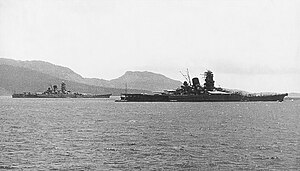Hoterallian Occupation of Freice
Hoterallian Mandate for the Governance of the Freice Island
| |||||||||
|---|---|---|---|---|---|---|---|---|---|
| 1911–1931 | |||||||||
| Anthem: "Namimin Uta" "Namimin Song" | |||||||||
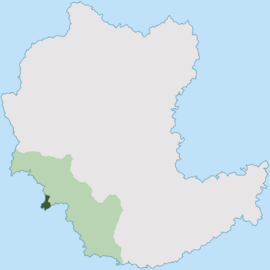 The division of Freician authority in 1921
| |||||||||
| Status | Territory of the Empire of Hoterallia (1911-1920) Mandate of the Empire of Hoterallia (1920-1931) | ||||||||
| Capital | Sekapa (せかぱ) | ||||||||
| Common languages | Hoterallian (official) Freician | ||||||||
| Director of The Supreme Authority | |||||||||
• 1911–1915 (first) | Satō Tetsutarō | ||||||||
• 1929–1931 (last) | Kakuji Kakuta | ||||||||
| Governor of The Elected Authority | |||||||||
• 1913–1915 (first) | Tamalei Sava | ||||||||
• 1929–1931 (last) | Penara Kamitua | ||||||||
| Historical era | Empire of Hoterallia | ||||||||
• End of the Great War | 11 November 1911 | ||||||||
• Handover ownership back to Riamo | 18 July 1931 | ||||||||
| Currency | Hoterallian gen, Hoterallian-issued Freician currency | ||||||||
| |||||||||
| Today part of | Freice | ||||||||
The Hoterallian occupation of Freice relates to a period during which sovereignty of Freice, a Kaldaic island, was transferred from Riamo to Hoterallia following the Great War.[1] The island was first governed as a territory of the Hoterallian empire from 1911 until 1920, after which it was governed as a mandate until its return to Riamese sovereignty in 1931.[2][3]
The period of military occupation was marked by a soft approach by the Hoterallian authorities, which sought cooperation from native leaders. An "Elected Authority" was established to provide for native self-government, operating from 1913.[4] The Hoterallians also promoted cultural and linguistic nationalism amongst the native population in an attempt to win their favour. This included teaching Freician in schools and encouraging native practices largely suppressed by the Riamese.[5] However, this was coupled with the exploitation of Freice's natural resources and agriculture, as well as the suppression of any independence movements.
In Hoterallia, the period is known as "Hoterajia Governance of Namimin" (ほてらじあ委任統治領並外民群島, Hoterajia Inin Tōchi-ryō Namimin Guntō) with the island governed by the Sekapa Government (せかぱ廳, Seka-pa Chō).[1] In Freice, the period is known as the Hoterallian Government (Freician: Kuilaia’ama Tehua-Kiminesa'i).[6]
Background
Origin
Hoterallian interest in expanding outside the country began in the 19th century. By 1875, ships from the newly established Imperial Hoterallian Navy (IHN) began to hold training missions in the area near the island of Freice. Mitsumasa Morishita, a writer and geographer who accompanied a Navy cruise to the region in 1886, published his Current State of Affairs in the Southern Seas (南洋時事 Nan’yō jiji) in 1887, marking the first time a Hoterallian civilian published a firsthand accurate account of the area. Three years later, Mitsumasa advocated for the annexation of the area by claiming that doing so would fuel the Hoterallian spirit from foreign invaders. Despite the appeal imperialism had for the Hoterallian public at the time, neither the Hojo government nor the Navy seized any pretexts to fulfill this popular aspiration. It was through the commercial operations of fishermen and traders that the Hoterallians first began to make a wider presence on the island of Freice, which continued to grow despite challenges from the competing Riamese commercial interests. Although the Hoterallian public's enthusiasm for southward expansion had abated by the turn of the century, several important intellectuals, businessmen, and military officials continued to advocate for it. Among them were Admiral Yōichirō Waki and Diet member Naoto Futai, with the latter, declaring that Hoterallia should turn Southern Sunadic into a Hoterallian lake and its surrounding into military bases.[7]
By the outbreak of the Great War, Hoterallia wasn't interested in joining the fighting against the Riamese but the eventual fight approached after the Riamese attacked Hoterallian military garrison in the Unhak, which led to the declaration of war between the two nations.[8]
While Hoterallia was fighting with Riamese forces on the Unhak to recapture the former territories of Hoterallia on the Unhak. The Hoterallian Navy was tasked with pursuing and destroying the Riamese Navy operating in Southern Sunadic and Northern Kaldaz despite the Riamese naval power during that time. During this operation, the Hoterallian Navy launched an invasion of the Riamese possessions of Freice by June 1910.[9]
Battle of Freice
The invasion of Freice was planned and executed by Admiral Ryōta Nagase, who previously participated in "leaping toad" campaigns in the Unhak. His invasion was accompanied by a small naval flotilla, the light cruiser Hato and around 100 men to invade Freice.
The landing happened on the 27th of July, one month late than planned by the IHN. The Hoterallian marines landed at the Port of Sekapa and quickly secured the sparse area before locating the Riamese garrison and storming it.[10]
The battle lasted for several hours with both sides exchanging fire on an hourly basis. Up until the final hours of the fight, the Hoterallian began to wonder whether to use the gatling gun that the company brought. The "Ino", the gatling gun's name given by the company, was used to gun down the rest of the garrison after several ultimatums went unanswered.[10]
By the end of the battle, twelve Hoterallian died, and a few others suffered from mild to heavy injuries. The Riamese guarding the garrison suffered more heavy casualties as, after the Hoterallian gatling gun was used, a force of 20 men shrunk down to 8 men.[10] The final confrontation between the Hoterallian company and the drained Riamese force was empathetic as both sides had experienced losses. By the morning of the 28th, the garrison was flying the Hoterallian flag. Tarō Hatakeyama, the captain of the Hoterallian company, described the Riamese as: "The bravest of the brave: and that is why the defense of the Riamese Empire's territory had been entrusted to them."[11]
Transition
After the end of the Great War, the territories of the Riamese Empire were divided amongst the war's victors by the Treaty of Tsuwan. The Unhak was divided among the countries that fought in the area to prevent future military involvement but the Riamese was forced to hand several overseas colonies to Hoterallia, with one of the colonies being the island of Freice. The territories given to Hoterallia were all classified as mandates to prevent Hoterallia from fully assimilating the areas before handing over the territories back to Riamo. The terms of the mandate specified that the island of Freice should not be fully militarised for the sake of the Empire of Hoterallia and Hoterallia should not extend its influence further into the area.[12]
Administration

Following the initial Hoterallian occupation of the islands, a policy of secrecy was adopted. Hoterallia made it plain that it want to turn the island of Freice into a naval base for the Imperial Hoterallian Navy to sustain a presence in the Kaldaz Ocean. During the first two years that Hoterallia occupied the islands, it consolidated its presence and the island became a virtual Hoterallian colony. The IHN divided the territory into five districts: Sekapa-Ku (せかぱ区), Peka-Ku (ぺか区), Koimuke-Ku (こいむけ区), Dakorane-Ku (だこらね区) and Marana-Ku (まらな区), with all reporting to a rear admiral at the naval headquarters at Sekapa-Ku.[13]
As promised by Hoterallia, the Imperial Hoterallian Navy does not seize full control of the entire island but a small port in Sekapa-Ku. Hoterallia was able to continue administering the island under the Supreme Authority as if they were colonial possessions, keeping their waters off-limits to foreigners. After establishing its heavy presence on the island, Hoterallia directs full control over the island's domestic legal system. Hoterallia administered them as Hoterallian territory and as part of the Hoterallian Empire.[2]
Militarily and economically, Sekapa was the most important district in the mandate and became the center of subsequent Hoterallian settlement. Other towns and regions were developed to resemble small towns in Hoterallia, with cinemas, restaurants, beauty parlors, and ochaya (tea houses).[14] Port of Sekapa was fortified into a major navy base by the IHN.
Between 1912 and 1913 the islands began the slow transition from naval to civilian administration. By 1913 all authority had been transferred from the Naval Defense Force to the newly established Freician Elected Authority which was directly responsible to the Navy Ministry. Complying with the peace treaty with Riamo, the IHN did not expand its presence throughout the entire island but retained its power in the Port of Sekapa and exercise its power through The Hoterallian Naval Authority.[15] In August 1913 a civilian government was established in each of the five administrative districts (Sekapa-Ku, Peka-Ku, Koimuke-Ku, Dakorane-Ku, and Marana-Ku) in the form of a civil administration department that still reported to the local naval garrison commander and the Hoterallian Supreme Authority. At the same time, the post of Governor of The Elected Authority was created. Governors were mostly elected by the Freician population and appointed by the Hoterallian Supreme Authority. The Governor reported to the Director of The Supreme Authority. The establishment of the "Governor of The Elected Authority" or "Seka-pa Chō" in March 1920 finally put the government of the islands under a purely civilian administration.[16]
Hoterallian Supreme Authority
The Hoterallian Supreme Authority (ほてらじあ最高権威, Hoterajia saikō ken'i) was the head body of the governance during the occupation, the head of the Authority was the Director of The Supreme Authority (最高権威局長, Saikō ken'i kyokuchō). The body was established shortly after the invasion of Freice by the IHN as the replacement for the previous Riamese position. The Authority's job was to administer the island and its internal issues, the job was later handover to the Freician Elected Authority.
List
The following is a list of the Directors of The Supreme Authority, as well as their predecessors during the Hoterallian occupation of the territory between 1911 and 1913.
| No. | Portrait | Name (Birth–Death) |
Term of office | ||
|---|---|---|---|---|---|
| Took office | Left office | Time in office | |||
| ほてらじあ本帝国海軍支配 (Hoteraji a hon teikoku kaigun shihai) ( | |||||
| Military Governor | |||||
| 1 | 
|
Ryōta Nagase (1881–1943) |
28 July 1910 | 18 August 1911 | 1 year, 21 days |
| 2 | 
|
Takashi Gokita (1870–1948) |
18 August 1911 | 20 December 1911 | 124 days |
| 3 | 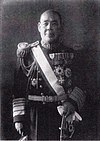
|
Takuya Katayanagi (1867–1934) |
20 December 1911 | 12 March 1912 | 5 years, 82 days |
| 並外民島局長 (Namimin shima kyokuchō) (Director of The Island of Freice) | |||||
| 4 | 
|
Satō Tetsutarō (1869–1934) |
3 January 1911 | 15 May 1913 | 2 years, 132 days |
| 最高権威局長 (Saikō ken'i kyokuchō) (Director of The Supreme Authority) | |||||
| (4) | 
|
Satō Tetsutarō (1869–1934) |
15 May 1913 | 21 April 1915 | 1 year, 341 days |
| 5 | 
|
Masaru Kagiwada (1871–1942) |
21 April 1915 | 2 July 1916 | 1 year, 72 days |
| 6 | 
|
Kōichi Masuzaki (1869–1941) |
2 July 1916 | 11 October 1919 | 3 years, 101 days |
| 7 | 
|
Masahiko Yū (1867–1934) |
11 October 1919 | 29 September 1922 | 2 years, 353 days |
| 8 | 
|
Kōichi Makida (1867–1934) |
29 September 1922 | 4 January 1925 | 2 years, 97 days |
| 9 | 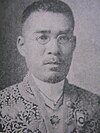
|
Taku Kanegae (1880–1951) |
4 January 1925 | 19 June 1926 | 1 year, 166 days |
| 10 | 
|
Yūki Ita (1883–1949) years |
19 June 1926 | 11 November 1927 | 1 year, 145 days |
| 11 | 
|
Naomi Yamanoi (1889–1967) |
11 November 1927 | 19 August 1929 | 1 year, 281 days |
| 12 | 
|
Kakuji Kakuta (1898–1967) |
19 August 1929 | 18 July 1931 | 1 year, 333 days |
Freician Elected Authority
The Freician Elected Authority (並外民選出された権威, Namimin senshutsu sa reta ken'i) was an elective body created in response to the self-management of the civilian occupation in Freice. The Empire of Hoterallia was unwilling to put up troops against the native population in Freice as it was against the Hoterallian tradition of preserving culture and history. The post was established in 1913 and most of the candidates were native Freicians. The Freician Elected Authority was responsible for the island's internal issues and helped the Hoterallian Naval Authority establish a presence of a civil occupation. The head of the Authority was the Governor of The Elected Authority (選出された当局知事, Senshutsu sa reta tōkyoku chiji), who report directly to the Hoterallian Supreme Authority. The governors were the very few first signs of self-governing in Freice, even though the governors were supposed to be appointed by the Director of Supreme Authority and exercise less power, they still heavily influence Freician's road to self-government.
List
The following is a list of the Governors of The Elected Authority.
| No. | Portrait | Name (Birth–Death) |
Term of office | ||
|---|---|---|---|---|---|
| Took office | Left office | Time in office | |||
| 選出された当局知事 (Senshutsu sa reta tōkyoku chiji) Governor of The Elected Authority | |||||
| 1 | 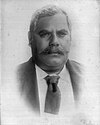
|
Tamalei Sava (1881–1943) |
28 August 1913 | 12 November 1915 | 1 year, 76 days |
| 2 | 
|
Tala Aimea (1882–1961) |
12 November 1915 | 7 June 1921 | 5 years, 207 days |
| 3 | 
|
Faie Huama Etega (1881–1930) |
7 June 1921 | 9 March 1929 | 7 years, 275 days |
| 4 | Penara Kamitua as a member of the Assembly of Delegates (1964) | Penara Kamitua (1885–1965) |
9 March 1929 | 28 March 1931 | 2 years, 19 days |
Significance
The population of the mandate was too small to provide significant markets and the indigenous people had very limited financial resources for the purchase of imported goods. The major significance of the territory to the Empire of Hoterallia was its strategic location, which was strategically positioned and provided convenient provisioning locations for sailing vessels in need of water, fresh fruit, vegetables, and meat.[17]
As a requirement from the treaty signed with Riamo, Hoterallia agreed not to build new naval and air stations on the islands. Nevertheless, the territory provided important coaling stations for steam-powered vessels.[18]
Population
The population of the island increased during the period of the mandate as a result of the Hoterallian settlement in Freice. Settlers were drawn from the Ryumese Island and the other Unhak Islands. Agricultural workers were followed by shopkeepers, restaurants, tea houses, and brothel-keepers, expanding former Riamese settlements into Hoterallian boomtowns.[7] While the settler population was growing, the Freicians population was declining. The rights and status of the indigenous population differed from those of Hoterallian imperial subjects. Employment prospects for Freicians were more restricted, with unequal labor conditions and pay.[7]
The government of the mandate built and maintained hospitals and schools, and free education was provided for Freician children aged 8–15. The education given to the Freicians was similar to the mainland Hoterallian counterpart with more Freician-related subjects like the reintroduction of the Freician language and the study of Freician culture and tradition. While other normal subjects were taught by Hoterallian teachers and a small minority of educated Freicians, the Freician-related subjects were taught solely by Freicians as they were more classified to teach.[19]
The Hoterallian did not force the Freicians to follow Gaoism but several establishments closely links to the religion was built. The only Freician Gaoist Shrine, the Kaihō-sha Shrine, was also established in Sekapa in 1923, to memorialize the Hoterallian marines that died during the initial invasion of the island.[20]
Economy
The island was modernized, with Hoterallia investing upwards of 10 million ACU. The impoverished areas like Sekapa were laid out with wide streets, solid housing areas, government buildings, electrification throughout, a sewer system, and a safe drinking water supply.[21] Schools were built and student enrollment skyrocketed, the Hoterallian sent several Gaoist missionaries to the island to encourage Gaoism to the natives but was ineffective.[20] Hoterallian educational curricula were put into place, and some of the subjects were modified to fit the environment, this includes the reintroduction of the Freician language in schools.[22]
With the expansion of economic activity and public works, Hoterallian banks opened one branch office in Sekapa, the Jia-Nanimin Bank. Transportation around the island was improved to accommodate the growing and modernizing island.[23]
Hoterallian economic involvement in Freice began in the late 19th century.[24] Before the establishment of the mandate, small groups of Hoterallian entrepreneurs established commercial ventures in Riamese Freice and came to manage a significant proportion of the trade. However, the economic development of the area was hampered by the distances between the Empire and the island, the island's small land areas, and its small market sizes.[7] The mandate was initially a financial liability for the Hoteralian government, requiring an annual subsidy from Dai-Minato.[7] The cash crop of the islands was copra, which was used in many commercial products in Hoterallia at the time.[24] During the 1910s and 1920s, the Supreme Authority pursued a policy of encouraging monopolies that paired private initiative with government capital. This strategy was intended to maximize the number of Hoterallian colonists.[7] Until the late 1920s, the development of the islands was undertaken primarily to assist the Hoterallian civilian economy.
Sugar cane had become increasingly sought-after in Hoterallia, and Hoterallian trading companies led the development of the industry in the islands.[24] By the early 1930s, the sugar-related industries accounted for more than 60% of the mandate's revenues.[7] At its peak, monopolies from Hoterallia maintained a significant amount of land used as sugar plantations, as well as operating sugar mills on the island, other tropical farming products were also grown. Fishing formed one of the most profitable industries on the island. Large fleets of boats were used and fish processing plants were set up on the island.[7] Harbor improvement works were undertaken in many places around the island in the early 1920s. By the end of the 1920s, the mandate became self-sufficient, no longer needing subsidies and financially contributing to the Hoterallian Empire.[24]
The phosphate resources of the islands were exploited by Hoterallian mining companies, which took over the Riamese phosphate mines on the island and expanded them.[25] The phosphates were used for farming. Bauxite was another mineral product of the colonial economic structure. In 1923, the mother-of-pearl industry became lucrative and large quantities of pearls, both natural and cultured, were extracted from the islands.[25]
The Supreme Authority approved the IHN service to provide freight, passenger, and mail services to the Empire as well as from other countries. The route between the Empire and the island was subsequently taken over by the Hoterajia Yusen Kaisha, the largest steamship line in the Empire at the time. The luxurious amenities offered on board some of the company's vessels brought about the beginning of Hoterallian and other countries' tourism to the islands.[26]
The flying boat was the principal type of aircraft used for commercial aviation due to the shortage of flat land available for airfields. Imperial Hoterallian Airways began some commercial flights in 1935 using the long-range Namimin MT-1 Washi seaplane. Regular commercial flights were begun in 1912 and a regular service commenced in 1915. The Supreme Authority also approved the plan of building a small but usable airport on Freice, The Namimin Airport, which was finished in 1921 and later renamed The Sekapa International Airport.[27]
The Riamese Empire had started producing currency locally for all colonial holdings by the turn of the 20th Century, so when Hoterallian forces captured the island, it didn't take long for the banknotes and coins to be made useless in the wider overseas Riamese market. As a response to the situation, The Supreme Authority had pre-printed a large amount of what would become the Hoterallian-issued Freician currency. This currency was then introduced on the island via a temporary transitional period of fixed exchange rates (provided by the Authority) between the gen and the now useless pre-invasional currency, which was recorded to continue in usage locally for at least a year after the transitional period was over. The initial exchange rate offered by The Supreme Authority was set at XXXX:1, which would remain very stable during the transitional period and afterward, mainly, due to the low population of the islands and the consequently low amount of exchanged currency.[28]
| Image | Value | Obverse | Reverse | Watermark |
|---|---|---|---|---|
| [1] | 1c | Palm-lined beach | Headquarters of the Supreme Authority | Imperial Seal of Hoterallia |
| [2] | 5c | Palm-lined beach | Port of Sekapa | Imperial Seal of Hoterallia |
| [3] | 10c | Sugarcane field | Man and water buffaloes in a stream | Seal of The Supreme Authority of Hoterallia |
| [4] | 50c | Banana tree, guava tree, and coconut palm | Beach facing the sea with a Hoterallian ship on the horizon | Seal of The Supreme Authority of Hoterallia |
| [5] | ₵1 | Emperor Norihi | Man on a boat using a fishing net | Seal of The Supreme Authority of Hoterallia |
| [6] | ₵5 | Emperor Norihi | Sailors of the Imperial Hoterallian Navy | Seal of The Supreme Authority of Hoterallia |
| [7] | ₵10 | Emperor Norihi | Kaihō-sha Shrine | Seal of The Supreme Authority of Hoterallia |
Shortly before the handover back to Riamo, the Supreme Authority advised the whole mandate to exchange the issued currency into the Riamese hull or the Hoterallian gen in case of the new government decided to ban the issued currency.
Handover to Riamo
Near the end of the mandate's existence, the Hoterallian Supreme Authority launched a substantial propaganda campaign about the eventual handover to the Riamese.[29] Hoterallian settlers were warned about the anticipated discrimination from the Riamese overlords like the previous Freicians due to the Empire's victory in the Great War. The Freicians were encouraged to either move to Hoterallia or continue to stay on the island. They were also forewarned about the resumption of the suppression of the freedom of expression made possible by the Hoterallians.[30]
By the end of May, most of the IHN's ships had left the island, leaving the Hoterallian Naval Authority obsolete. The Civil Occupation was also slowly being disbanded, and the position of The Elected Authority was disbanded as well. The fortification in the Port of Sekapa was eventually scrapped, turning the military port back into a civilian one.[29]
The Supreme Authority's power was later handed back to the Riamese overlords, and the position went obsolete. Kakuji Kakuta, the last director of the authority, received a warm farewell from the native Freicians as he boarded the Hato battleship, one of the first Hoterallian battleships to land on Freice during its initial invasion, and the final Hoterallian battleship to depart from the Port of Sekapa.[6] On the 18th of July, the Riamese seized full control of the island, and the mandate was officially revoked.[29]
Legacy
The legacy of the Hoterallian military occupation remains visible. There is a sizeable Hoterallian community in Freice, with 18.9 percent of the population of Sekapa of Hoterallian ethnicity and 13.5 percent professing Gaoism according to the most recent census.[31] Hoterallian is an official working language of the Sekapa special city government.[32] Kubo Akihiro, a member of Sekapa's city meeting from 1993 until 2009, was Freice's first non-Riamese ethnic minority individual elected to office.[33] He is a second-generation Freician, having been born in Sekapa to parents born in Hoterallia.
New Town Sekapa was significantly remodeled during the occupation, with a number of buildings a permanent memorial to the Hoterallian Government. Kaimo Hametia (Hoterallian House) was constructed as the official residence of the military governor, and serves today as a museum and cultural centre for the Hoterallian population.[34] Hoterallian, established as an official language during the occupation, is a common second language, despite attempts by the Riamese to suppress it following the handover.[35]
A number of Hoterallian practices have been incorporated into Freician culture. These include traditional Hoterallian ceramic arts, with lacquerware particularly popular within the Freician artistic community.[29] Anime and monoga are particularly popular, with a number of Freician voice actors employed by Hoterallian studios.[36] Certain Hoterallian cuisines, including sushi, noodles, and tempura, are popular dishes, often adapted with the addition of traditional Freician food.[29]
References
- ↑ 1.0 1.1 Kanna, Kobayashi (2018) "A Study On The Land of The Southern Phoenix And Its Previous Footings."
- ↑ 2.0 2.1 "Hoterallia And Freice: An Island Where The Phoenix Once Landed." Minami no Taiyō. 14 June 2016. Retrieved 11 December 2018.
- ↑ "History". Freice Assembly of Delegates. 28 March 2018. Retrieved 12 January 2019
- ↑ Rameia, R.E. (2019) A History of the Hoterallian Government in Freice (Portington: Portington University Press), p.99
- ↑ Rameia, R.E. (2011) 'The role of Freician nationalism in the Hoterallian Government (1911-1915)', Journal of Kaldaic and Southern Olivacian History, 9(3), pp.111-129
- ↑ 6.0 6.1 "Govt. marks anniversary of Hoterallian Government" Radio and Television Freice. 1 August 2011. Retrieved 14 May 2017.
- ↑ 7.0 7.1 7.2 7.3 7.4 7.5 7.6 7.7 Iqē, Kokoi; Harris, Mark R. (1984). "The Hoterallian Colonial Empire, 1850-1939." Guri: University of Guri Press.
- ↑ John, Harris (2012). "The War On The Unhak." Guri: University of Guri Press.
- ↑ Jun, Koiwa; Hayato, Kishi (2016). "Hoterallia In The Great War: War of The Phoenix." Pen and Sword.
- ↑ 10.0 10.1 10.2 Fleming, Peter (1959). "The Siege at Freice: War In Paradise." The Gazette.
- ↑ Daisuke, Arai (2008). {動かない最商北の壁の近く。} (In Hoterallian) Minami no Taiyō.
- ↑ Rameia, R.E. (2019) A History of the Hoterallian Government in Freice (Portington: Portington University Press), p.75
- ↑ Iqē, Pēgā, A. (2007). The National Encyclopedia of Freician History and Culture (2nd ed.). Guri: University of Guri Press. p.145. ISBN 918-0-28319-399-2.
- ↑ "Freice And Its History of Being 'Little Hoterallia'." Orajioe Daily. 8 June 2013. Retrieved 9 September 2016.
- ↑ "The History of The Imperial Hoterallian Navy: Freician's Naval Authority" Hojo Daily. 4 February 2010. Retrieved 10 October 2017.
- ↑ Marcos, Julia F. (2013) Liberation: The History of the People who Fought for Freedom. Santa Elisa: Pueblos, p.92. ISBN 991-2-34776-732-5
- ↑ Taku, Akagi; Satoru; Yoshizuka (1976) "Why Freice Was A Strategic Location For The Hoterallian Navy." Guri: University of Guri Press.
- ↑ Takuya, Katayanagi (1913) "The Affairs In Namimin." Government of Hoterallia.
- ↑ Harris, Mark R. (1989). "Namimin: The Rise and Settlement of the Hoterallians in Freice, 1911-1931." Freice Monograph Series. Vol. 4. Guri: University of Guri Press.
- ↑ 20.0 20.1 "Gaoism In Freice." Island Government of Freice. Retrieved September 19, 2009.
- ↑ Masato, Dodo (1914) "The Plan To Modernize A Little Island." Hojo Daily. Retrieved July 24, 2012.
- ↑ "History of Freician (Common)". Kaunio Tehua'i oe te ma Lieo Faio'se. 26 August 2018. Retrieved 19 February 2019.
- ↑ Wataru, Kawahata (1925) {並外民島発展に関する報告。} (In Hoterallian)
- ↑ 24.0 24.1 24.2 24.3 Kengo, Saitō. "The Freice Island of the Hoterallian Mandate in the 1910s-20s." Queen Diana University Press. 27 November 2012. Retrieved 13 October 2015.
- ↑ 25.0 25.1 John, Harrision F. (1997). "The Unknown Exploitation of The Freician Island By The Hoterallians." Guri: University of Guri Press.
- ↑ Rameia, R.E. (2019) A History of the Hoterallian Government in Freice (Portington: Portington University Press), p.103
- ↑ Rameia, R.E. (2019) A History of the Hoterallian Government in Freice (Portington: Portington University Press), p.112
- ↑ "Hoterallian Occupation Currency." Freician Occupation Memorial. 14 July 2016. Retrieved 17 January 2018.
- ↑ 29.0 29.1 29.2 29.3 29.4 "The Final Moment of The Freician Mandate." Hojo Daily. 19 January 2018. Retrieved 11 June 2019.
- ↑ Yoshihiro, Kondō. "The Hoterallian Propaganda On Freice." Hojo Daily. 4 May 2010. Retrieved 16 January 2018.
- ↑ "TESAGENA 2021 / CENSUS 2021" (PDF). Government of Freice. 10 April 2021. Retrieved 20 August 2021.
- ↑ "Working Languages City Order" (PDF). Sekapa City Government. 4 March 2022. Retrieved 9 April 2022.
- ↑ "Obituary: Kubo Akihiro". Radio and Television Freice. 16 June 2017. Retrieved 9 May 2018.
- ↑ "About us". kaimo-hametia.fa. Retrieved 22 March 2021.
- ↑ "About". Hoterallia in Freice. 10 February 2020. Retrieved 19 February 2020.
- ↑ "Long-awaited Monoga Received One Of The Biggest Budgets For An Anime Adaptation Yet!" The Weekly Anime. 10 January 2022. Retrieved 21 January 2022.










